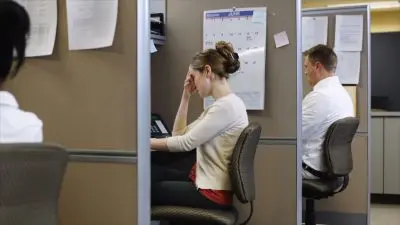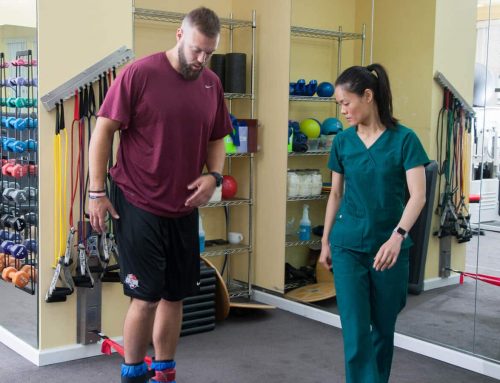If you work a 9 to 5, read this.
Millions of Americans work a desk job and are sedentary the majority of the day- chances are likely that you are one of them. If you fall into this category, you’re probably aware of the negative effects that sitting all day can have on your body. In what ways does it affect you? It isn’t necessarily the act of sitting but rather the sedentary posture that poses potential danger to your overall health and wellness.
It would seem logical that back pain would be more prevalent with those working in physically demanding fields – for example, those in construction or restaurant waitstaff. Sitting in front of a desk all day, however, can have the same, if not worse, effects on your musculoskeletal system. Our bodies are not meant to be stationary for extended periods of time, especially for the length of a typical workday – eight hours or more.
You can combat the associated aches and pains that come with sitting by getting up every few hours. It is important that you give your body a break from being in the same position all day and moving your body will help a lot. Getting lots of exercise also helps. Studies show that it takes approximately an hour of exercise to counteract the effects of sitting for ten hours a day. The exercises don’t have to be anything strenuous either – even walking helps.
What about for all the hours you are sitting? When you’re spending so many hours in front of a monitor and engulfed in work, the last thing you are probably thinking of is your posture. After all, we can’t all be conscious of our posture all day every day. That is why most of us sit hunched over the majority of the time. By maintaining this type of posture five days a week, the result tends to be back pain and neck and shoulder tension.
Combat these pains by practicing good ergonomics. Have your eyes level with the monitor so that your neck isn’t cranked. Knees should be bent at a 90-degree angle and level with the floor. Keep your shoulders back so that you’re not leaning forward towards the screen. If your shoulders are raised towards your ears, that means they are hunched and rounded and need to be brought down.
What happens when you don’t practice good posture? For one, if you aren’t sitting with perfect posture, your body overcompensates to make up for the imbalances. Sitting slouched and hunched over doesn’t just impact your upper back and shoulders. It affects your whole body. For example, when you’re sitting with poor posture, your hip flexors become tight so your glutes overextend to make up for it. Not only that, your shoulders and neck become stiff, the discs in your spine become compressed, muscles weaken, extra stress is placed on your joints and your circulation and metabolism slows.
If you sit at a desk all day, combat its associated effects by incorporating these exercises into your daily routine:
Half-Kneeling Flexor Stretch
Start in a standing position and place your hands on your hips. Place one foot forward and lunge your left foot forward until both of your knees are bent at a 90-degree angle. Hold and do the same with your right foot lunged forward while the left foot stays back and forms a 90-degree angle.
Squats
Start with your feet hip-width apart. While keeping your arms straight out in front of you, move your torso down towards the floor as if you were about to sit down in a chair. Hold for a moment and return to your starting position. Repeat 15-20 times while ensuring that your back remains straight.
Single Leg Squat
This move takes a lot of balance and practice but is easy once mastered. As the name suggests, you will be squatting on one leg. Start standing with all your weight on one leg as the other leg is slightly off the ground (you may want to choose to stand on your more dominant leg to start). The same way you would do a squat, bend the one leg that is firmly on the ground in the same manner as a normal squat. The difference here is that since you are only bending one leg in that 90-degree angle, you will want to keep the other leg straight out.
In other words, the leg that is not firmly on the ground will never be bent. Work on reps of 10 and then alternate legs.
Plank
Strengthening the abdominal muscles will help your lower back support the weight on your spine. A plank looks very similar to a pushup however instead of having your arms straight out you will rest your weight on your elbows and bring your hands together so that they are clutched. Your elbows should be sitting at a 90 degree angle. Hold this position for 30 seconds while you flex your abs and glutes.
Leg Swings
With one leg stationary, swing the other leg forwards and backwards 20 times. Then switch legs. After 20 reps on each leg, switch the swing to side to side. For both swings, try to swing as high as you can. This exercise will help loosen up the hips.
Chest Stretch
This is best done within a door frame. With the door open (if there is one), stand in the middle. Place both forearms on the frames so that you are making a square “u” with your arms. Lean forward into the stretch as if you are walking away from the door and hold for 20 seconds. This will open up your tight upper body muscles.
Sitting for extended periods of time can have short and long-term effects on your health. If the above preventative measures aren’t enough, our team at Empire Physical Medicine can also assist. Reach us at (646) 665-7109 to request an appointment and see how we can help you today.
Published By:
Empire Physical Medicine & Pain Management
7 W 45th St floor 9,
New York, NY 10036
Phone: (646) 665-7109
Website: https://manhattanpainrelief.com






